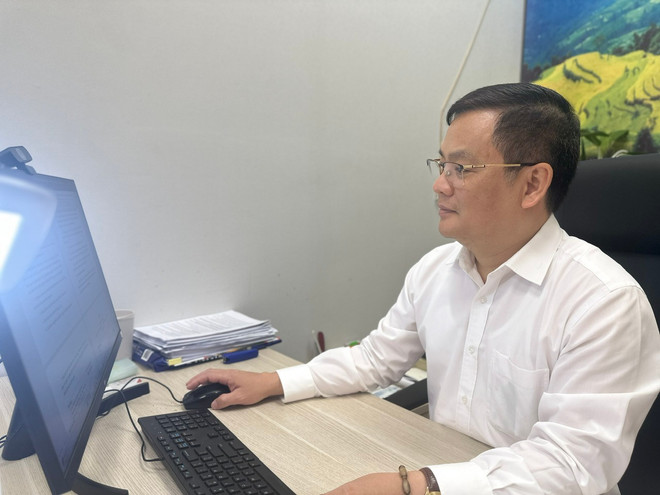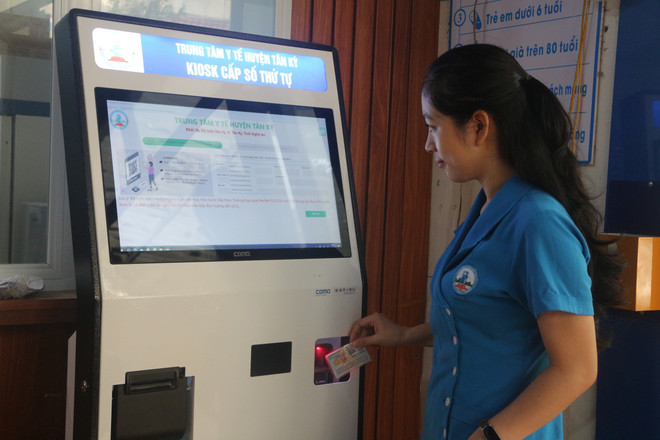Circular 26/2025/TT-BYT, which has just been issued, not only adds mandatory information fields to prescriptions but also provides specific regulations on dosage, number of times to take the medicine per day, and duration of use. The technical changes are small but have great significance for patients. The Circular also sets out strict prescription principles, strengthens control of antibiotics and addictive drugs - moving towards implementing electronic prescribing nationwide from 2026.
Mr. Vuong Anh Duong - Deputy Director of the Department of Medical Examination and Treatment Management ( Ministry of Health ) shared with the press to clarify important contents surrounding this policy.
Reduce errors, increase treatment effectiveness
-Circular 26/2025/TT-BYT requires clearly stating “dosage per time, number of times per day, number of days of use.” Can you explain more clearly why this small detail has great significance in actual treatment?
Mr. Vuong Anh Duong: Up to now, when going to see a doctor, patients are given a prescription, which includes information such as the name of the medicine, the content, quantity, volume needed, etc. Those elements are still maintained. However, the new point in this regulation is to add more content about how to use the medicine more clearly.
For example, instead of just stating "take 4 pills per day, divided into 2 times", the regulation now requires specifically stating "how many pills per time", to avoid the situation where the patient divides the dose according to his/her understanding, maybe taking 3 pills in the morning, 1 pill in the evening or vice versa. Taking the medicine irregularly or at the wrong time will reduce the effectiveness of the treatment, even affecting health. Therefore, the new regulation requires clearly stating the number of times to take per day, how many pills per time.
This new point is a technical addition to the prescription, and the recording of the number of times to use each medicine per day was previously included in the regulations.
-In fact, people sometimes forget to take their doses during treatment. Will this new regulation help reduce this situation?
Mr. Vuong Anh Duong: Previous documents of the Ministry of Health (Circular No. 52/2017/TT-BYT) also stipulated that prescribers are responsible for providing instructions on drug use, nutritional advice, and lifestyle for patients or their representatives. The Law on Pharmacy also stipulates that drug sellers must provide specific instructions when selling drugs to patients.
Compliance with medication prescriptions is the responsibility of the patient and the patient's family (such as patients with mental disorders or pediatric patients). This new regulation only helps patients see the dosage of the medication more clearly - looking at the prescription can help them take it correctly, limiting misunderstandings and missed doses.
Controlling the sale of drugs without prescription
-Circular 26 sets out the prescription principle of "prescribing drugs only when absolutely necessary" - how will this be implemented?
Mr. Vuong Anh Duong: The prescription principle of “prescribing only when absolutely necessary” is actually stipulated in the Law on Medical Examination and Treatment 2023. This is a general principle in medical examination and treatment. Practitioners only perform medical examination and treatment services, or prescribe when absolutely necessary, and must not abuse it. In fact, prescribers must base on the diagnosis, the patient's medical condition, and the documents prescribed as the basis for prescription in the Circular to prescribe safe, reasonable, and effective drugs.
Mr. Vuong Anh Duong - Deputy Director of the Department of Medical Examination and Treatment Management (Ministry of Health). (Photo: PV/Vietnam+)
A very important point is that from October 1, 2025, all hospitals will have to implement electronic prescriptions and by January 1, 2026, all other medical facilities will also be required to implement electronic prescriptions. At that time, the prescription and drug sales systems will be connected. Patients who buy drugs will be controlled according to the prescriptions in the system. Which prescriptions are sold, which drugs are sold differently from the prescription, all can be tracked. This is a huge step forward in controlling the sale of drugs without a prescription, especially antibiotics.
- Circular 26 adds quite specific regulations on the responsibility to return addictive drugs, psychotropic drugs, and precursor drugs in cases where the patient does not use them all or has died, especially applicable in outpatient treatment. Could you please tell us more about how this new regulation will be implemented?
Mr. Vuong Anh Duong: The management of addictive drugs, psychotropic drugs, and precursor drugs has been regulated in the Law on Pharmacy, Government Decrees, and Circulars of the Ministry of Health for all activities in the chain: from raw materials, production, supply of drugs on the market, prescription, use of drugs in and outside medical examination and treatment facilities, to recall and disposal of drugs when not used up or when patients die.
One of the notable new points in Circular 26 is more specific regulations on the responsibility for prescribing, dispensing, refunding and handling of addictive drugs, psychotropic drugs and precursor drugs in outpatient treatment.
Specifically, according to Point b Clause 2 Article 12 of the Circular, when a patient no longer needs to use the medicine, does not use up all the medicine, or in the event of the patient's death, the patient or legal representative is responsible for returning the unused medicine to the medical examination and treatment facility that provided the medicine.
At the same time, Clause 3, Article 12 stipulates: medical examination and treatment facilities are responsible for receiving this portion of medicine and handling it according to current regulations on the management of addictive drugs, psychotropic drugs, and precursor drugs. This is to avoid the situation of sensitive drugs being lost, misused, or leaked into the market.
In addition, the Circular also emphasizes the role of the Department of Health and local professional agencies in ensuring adequate legal supply of these drugs to serve treatment needs in the area.
This is a step to concretize the contents stipulated in the revised Law on Pharmacy in 2024, and demonstrates efforts to tighten the management of special drugs, both ensuring the treatment rights of patients and preventing the risk of abuse, trafficking, and misuse.
Integrate personal identification numbers into prescriptions
-Circular 26 has just been issued requiring the integration of personal identification numbers into prescriptions. Why is this important at this time?
Mr. Vuong Anh Duong: Integrating personal identification numbers into prescriptions is an important step towards synchronizing medical data with the national population database system, in accordance with the spirit of the Government's Project 06. When people use their personal identification numbers, many administrative information such as full name, date of birth, gender, address, etc. will be automatically filled in from the system. This helps reduce prescription time, limit errors and simplify procedures for both patients and medical staff.
In the long term, this is also an important foundation for building a unified electronic health record, better serving the continuous health care and management of people's medical information.
Nghe An health sector deploys automatic queue numbering and electronic medical records to help patients easily monitor the medical examination and treatment process. (Photo: Bich Hue/VNA)
- When the traditional medical examination book form is removed - replaced by storing it in medical records, how will people in remote areas access it?
Mr. Vuong Anh Duong: From 2023, the Law on Medical Examination and Treatment has clearly stipulated that all outpatients at medical examination and treatment facilities must have their medical records established and updated. Accordingly, the traditional "medical examination book" form is replaced by a medical record, which is a step in line with modern development trends, ensuring complete, accurate and consistent management of medical information.
In particular, according to Directive 07 of the Prime Minister, hospitals nationwide must deploy electronic medical records in 2025. Therefore, standardizing medical records to replace handwritten medical records is not only a legal requirement but also an effort to ensure the rights and safety of patients.
The health sector has also anticipated difficulties, especially in remote areas, so training, technical support and communication to the people will continue to be promoted, helping the transition process take place smoothly, with the patient at the center.
-How will prescription management using software synchronized with national data control drug abuse?
Mr. Vuong Anh Duong: The interconnection between the Electronic Prescription System and the National Drug Administration System is one of the key solutions to improve the effectiveness of drug use monitoring. When all prescriptions are updated synchronously, the management agency can promptly detect and handle drug abuse, prescription errors or sale of drugs without prescription.
For people, using QR codes on electronic prescriptions makes it easy to look up information about the drug, dosage, instructions for use, and treatment history. This is a useful tool that helps patients proactively monitor their medication use, contributing to increased transparency and safety in drug use.
-In digital transformation, the role of primary care doctors and medical staff is key. What strategies does the Ministry of Health have to support them in improving their digital capacity in prescribing?
Mr. Vuong Anh Duong: We understand that the team of doctors and medical staff at the grassroots level is an important force that determines the success of the digital transformation process. Therefore, the Ministry of Health has issued detailed instructions and established an electronic prescription system with a friendly, easy-to-use interface that only requires basic computer skills.
In addition, many training courses and programs have been and are being held nationwide, helping medical staff master the electronic prescription process and integrate data into the common system. In the coming time, the Ministry of Health will continue to increase technical support, update software, especially prioritizing the grassroots health sector to ensure that all medical examination and treatment facilities can effectively implement, thereby serving the people in the best way.
Thank you very much!
(Vietnam+)
Source: https://www.vietnamplus.vn/buoc-tien-lon-kiem-soat-tinh-trang-ban-thuoc-khong-theo-don-thuoc-khang-sinh-post1048164.vnp


























































![[Maritime News] Treasury Department Targets Diverse Networks Facilitating Iran's Oil Trade](https://vphoto.vietnam.vn/thumb/402x226/vietnam/resource/IMAGE/2025/7/14/43150a0498234eeb8b127905d27f00b6)










































Comment (0)